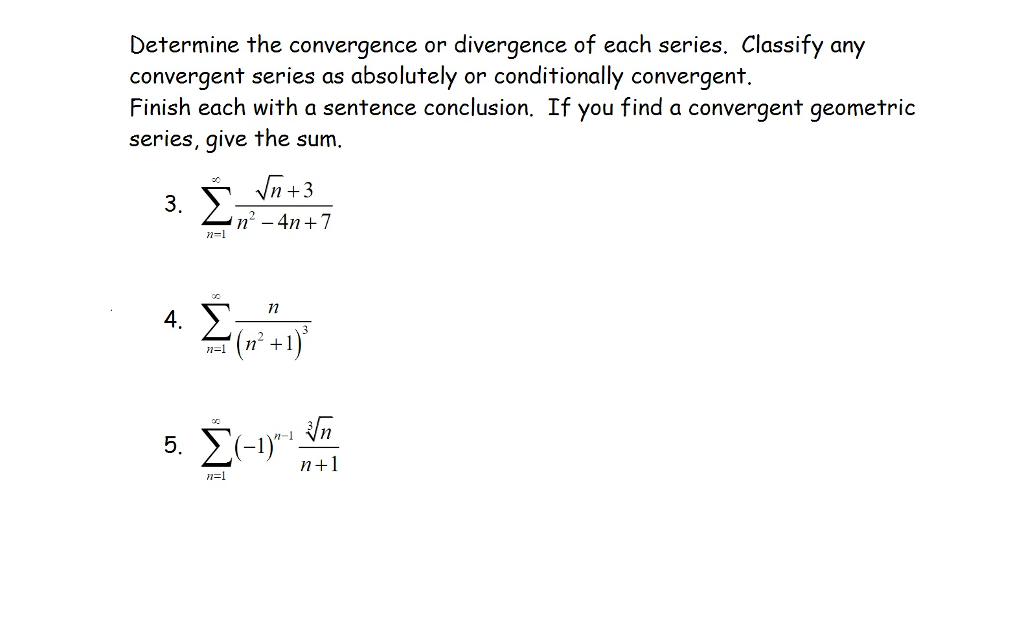
Hopefully you find that interesting.In numerical analysis, the order of convergence and the rate of convergence of a convergent sequence are quantities that represent how quickly the sequence approaches its limit. Take the absolute value of the terms, it converges. Sequences are used to study functions, spaces, and other mathematical structures.
#Sequence calculator convergence series
A series is convergent if the sequence converges to some limit, while a sequence that does not converge is divergent. It still converges when you take the absolute value of the terms, then we say it converges absolutely. Sequences have many applications in various mathematical disciplines due to their properties of convergence. Value of the terms, then you say it converges conditionally. The Summation Calculator finds the sum of a given function. Common ratio Ratio between the term a and the. Here's a brief description of them: Initial term First term of the sequence. These values include the common ratio, the initial term, the last term, and the number of terms. Might be interesting to say well, would it still converge if we took the absolute value of the terms? If it won't, if you converge,īut it doesn't converge when you take the absolute Enter the formula for which you want to calculate the summation. With our geometric sequence calculator, you can calculate the most important values of a finite geometric sequence. And what we're doing in this video is we're introducing a nuance So we've talked a lot already about convergence or divergence, and that's all been good.

So when we took theĪbsolute value of the terms, it still converged.

And here once again, the common ratio, the absolute value of theĬommon ratio is less than one, and we've studied this when we looked at geometric series.
#Sequence calculator convergence plus
Same thing as the sum, from n equals one to infinity of 1/2 to the n plus one. So the absolute value of negative 1/2, to the n plus one power, this is going to be the If you were to take the absolute value of each of these terms, If you were to take the sum, Let me do that in a different color, just to mix things up a little bit. And if we were to take the absolute value of each of these terms, so We know this is a geometric series where the absolute value Let's say, let's take the sum from n equals one to infinity of negative 1/2 to the n plus one power. Actually I'm using these colors too much, let me use another color. This series, let's do a geometric series, that might be fun. And if something converges when you take the absolute value as well, then you say it converges absolutely. I guess you could say, that we're not taking the absolute value of each of the terms. The figure below shows the graph of the first 25 terms of the. A sequence converges if its n th term, a n, is a real number L such that: Thus, the sequence converges to 2. We can determine whether the sequence converges using limits. You can say it converges,īut you could also say it converges conditionally. A convergent sequence is one in which the sequence approaches a finite, specific value. Series that converges, but if you were to take the absolute value of each of its terms,Īnd then that diverges, we say that this seriesĬonverges conditionally. So the harmonic series is one plus 1/2, plus 1/3, this thing right over here, this thing right over here diverges. Me, on the famous proof that the harmonic series diverges. And there's this video that we have, and you should look it up on Khan Academy if you don't believe And this is just theįamous harmonic series. The sum from n equals one to infinity of one over n. We have to satisfy that the absolute value of ( an. In a regular proof of a limit, we choose a distance (delta) along the horizontal axis on either side of the value of x, but sequences are only valid for n equaling positive integers, so we choose M. Going from one to infinity, so it's just going to be equal to the sum, it's going to be equal to M is a value of n chosen for the purpose of proving that the sequence converges. Of the absolute value of negative one to the n plus one over n, well what is this going to be equal to? Well, this numerator is either gonna be one or negative one, theĪbsolute value of that is always gonna be one, so If you were to take the sum from n equals one to infinity So if we were to take the absolute value of each of these terms, so Now let's think a little bitĪbout what happens if we were to take the absolute value If you wanna review that, go watch the video on theĪlternating series test.

So this converges by alternating series test. Series test in that video to prove that it converges. So this series, which is one, minus 1/2, plus 1/3, minus 1/4, and it just keeps going on and on and on forever. We used this as our example to apply the alternating series test, and we proved that this thing Series from n equals one to infinity of negative one, to the n plus one over n. We in fact used the series, we used the infinite Video where we introduced the alternating series test,


 0 kommentar(er)
0 kommentar(er)
